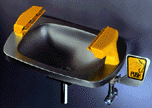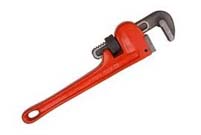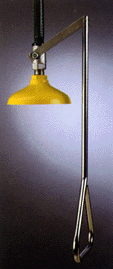Eyewashes and Safety Showers
This page was designed and developed to provide information to Purdue employees and students whose laboratories, rooms or hallways contain any safety shower or eyewash units. Purdue University has more than 1500 units, and units are being added as construction proceeds on the campus. After reading through the following sections you will have a better understanding of how your unit works and possible solutions to any problems that you may come across.
| Eyewashes | Safety Showers | Troubleshooting | Testing FAQ |
|---|---|---|---|
 |
 |
 |
 |
Eyewashes
The photograph below is of a properly functioning eyewash. It has a clear and even flow of water to the eyes.
To maintain your eyewash, there are just a few simple tasks:
Flush your eyewash weekly:
- Direct water into the floor drain if one is available, use a plastic bag to catch the water if your drain pipe does not extend to the floor drain or connect directly to an outgoing pipe.
- Protect surroundings from over spray, ensure electrical equipment is kept dry.
- When the water runs clear, you are finished.
Using your eyewash:
- If something gets into your eyes, get to the nearest eyewash station as quickly and safely as possible.
- Turn the eyewash on and use your hands to keep your eyes open.
- Have someone call 911 while you are flushing.
- Flush eyes thoroughly for at least 15 minutes and seek professional medical attention
Safety Showers
This shower below is activated by pulling down on a rigid handle attached to a lever activated valve. Pushing the lever back into its original position will stop water flow. Other showers may use a chain release valve for activation. When the chain pulled and released approximately 5-gallons of water flow before the unit shuts itself off.
Things to keep in mind when using a safety shower:
- Know exactly where the shower's water shut-off valve is located.
- Avoid placing place any electrical equipment near the unit.
- If your clothing is contaminated with chemicals, EHSove them before getting under the shower. Chemicals will stay on the body longer if clothing is not EHSoved.
- Continue under the shower for at least 15 minutes before seeking medical attention.
Troubleshooting
During the summer an eyewash/safety shower crew from EHS examines over 1500 units on campus making repairs and adjustments as needed. In the meantime, here are some solutions to problems that you might encounter with your eyewash or safety shower units. With these suggestions, we hope that you can fix your problem(s) easily.
| Problem | Solution |
| 1. I can't get to the shower. | 1. Keep pathway to shower open. |
| 2. Eyewash basin is full. | 2. EHSove items from eyewash basin. |
| 3. Electrical equipment is stored near unit. | 3. Relocate all electrical equipment and components. |
| 4. Eyewash spray is erratic. | 4. Fill out Form 18-A. |
| 5. Eyewash/ safety shower is leaking. | 5. Fill out Form 18-A. |
| 6. Eyewash water is discolored. | 6. Flush eyewash until water runs clear. |
| 7. Eyewash/ safety shower is needed. | 7. Contact the Safety Section at EHS. |
Testing Frequently Asked Questions
Q: I know that EHS checks my eyewash annually during the summer, but how do I know that my eyewash is working any other time that I might need it?
A: The American National Standard for Emergency Eyewash and Shower Equipment, ANSI Z358.1-2004, states, "Plumbed equipment shall be activated weekly for a period long enough to verify operation and ensure that flushing fluid is available." A note further states, "The intent is to ensure that there is a flushing fluid supply at the head of the device and to clear the supply line of any sediment build-up that could prevent fluid from being delivered to the head of the device and minimize microbial contamination due to sitting water."
Q: How do I check my eyewash if the eyewash drains directly onto the floor without a floor drain?
A: Eyewashes can be modified by your zone plumber to accommodate a 5-gallon bucket under the eyewash drainpipe. Turn in a work request with a departmental number or contact your building deputy to initiate the work.
Q: What if I find that the eyewash is not operating properly?
A: Turn in a work request with a departmental number or contact your building deputy to initiate the work. You should indicate "High Priority - emergency eyewash out of service" if your eyewash is not functioning.
Q: Can EHS check my eyewash for me weekly?
A: Sorry, EHS does not have the resources. It is the responsibility of the persons working in the laboratory or shop to weekly check the eyewash.
Q: Are there situations where I would want to check my eyewash more frequently than once a week?
A: In situations where you are working with very corrosive chemicals with high splash potential, a daily check would be advisable.
Q: You've only mentioned eyewashes, should I check my safety shower as well?
A: Yes! The ANSI code requiring eyewashes to be checked weekly also requires safety showers to be inspected weekly.
Q: How do I inspect the shower without flooding the lab?
A: This is a two-person operation. One person will position them self within arms reach of the manual shutoff valve located in the water piping leading to the safety shower. A ladder is sometimes necessary to get within reach. Test the manual valve for ease of opening and closing BEFORE testing the shower. If you cannot operate this manual shutoff valve, do not test the shower because the shower's release valve sometimes sticks in the open position. This is especially true with the pull-chain valve.
The second person will position him or herself under the shower and prepare to operate the pull valve. This is not the same as the manual valve. The pull valve is intended to operate the shower; turn it on or off. The manual shutoff valve is intended to shut off the water supply to the shower during maintenance and servicing. The second person standing beneath the shower places a five-gallon bucket under the showerhead to enclose it. Now, pull the shower release valve. The shower will gush water into the bucket at a rate of 20 gallons per minute. If chain operated, release the chain quickly. If lever operated, push the lever back up. The shower should shut off before the bucket is full. With a pull-chain valve, if the shower's self-closing valve sticks open and water does not stop flowing into the bucket, the first person at the manual shutoff valve must immediately close the manual shutoff valve. The same goes with the lever valve, but these are typically much more reliable.
Lastly, if the shower's self-closing valve sticks open and the shower has to be shut off manually, the shower and very likely the eyewash will be out of service. OSHA requires a functioning eyewash if using corrosive material or harmful substances to the eyes. A work order with your proper departmental account number must be immediately turned into the Work Control Center at 49-49999. Mark the work request with "High Priority - emergency shower out of service" and describe the work that needs to be performed. If possible, replace the pull-chain valve with a more reliable ball valve equipped with a rigid pull-down lever. These valves allow the shower to turn on and EHSain on until the lever is pushed back up, thus closing the valve.
Q: What if I have more questions?
A: You can call EHS at 49-46371.
Campus Safety Contacts

If you see something, say something.
Purdue Police
Phone: (765) 494-8221
Purdue Fire
Phone: (765) 494-6919
Sign up for Emergency Text Messages
Do you want to recognize one of our staff for a job well done? Nominate the staff member(s) for a Bravo Award here!

